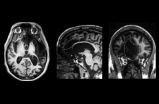IBC 2012: New standard HEVC encodes films more efficiently
2012-08-23
(Press-News.org) The opening ceremonies for the Olympic Games captivated countless viewers all over the world in front of their televisions, astounding them with a gigantic show. Relatively few people were able to have a live experience of the spectacle at the London stadium. Still, some of the fans watching the show felt as if they were there live, even though they were only sitting in front of a large cinema screen. That's because a few movie theaters showed the opening ceremonies in 8K-resolution, which corresponds to 33 megapixels.
The resolution on home televisions will soon be enhanced even further, conveying the feeling of being right in the middle of the action, instead of just watching from the sidelines. Indeed, the successor to the full HD television set is already penetrating the market: the 4K display, also called 2160p format. These televisions have four times as many pixels as the TVs in our living rooms today. Still, the continuously growing number of pixels must also be fed with the matching content, so that the capabilities of the high resolution television can also be utilized. But to do so has always been tied to immense costs, until recently, and therefore was only considered for major events, like the Olympic Games.
The previous standard for encoding data and sending it from the broadcaster to the home television set is known as H.264/MPEG-4 AVC. Theoretically, it has certainly been up to handling the mass of data; however practically, the broadcasting of higher resolution entails substantial costs: because an additional channel is needed for television broadcasts, and for Internet transmission, the server needs a wider bandwidth. A majority of the reputable electronics manufacturers have now joined forces to develop a new broadcasting standard together: HEVC, short for "High Efficiency Video Coding." The labs at the Fraunhofer Heinrich-Hertz-Institute HHI in Berlin, which played a critical role in the engineering of the H.264 predecessor standard, also made a substantial contribution to this new standard.
Twice as efficient as H.264
The advantage of HEVC: The standard requires half the bandwidth for high quality video transmission. But how is it being done? "Parts of H.264 were subsumed and optimized," explains Dr. Thomas Schierl, group manager of multimedia communications at HHI. "One example is the block size: whereas H.264 subdivides the transmission image into blocks of 16 by 16 pixels, HEVC instead carves the image into blocks of varying sizes with up to 64 by 64 pixels. These larger blocks can be encoded considerably more efficiently." If an object is seen in the image that moves to the side, then this movement occurs smoothly. The standards establish the movement data for each block - data that is ordinarily transmitted once per block. Because the blocks in HEVC are substantially larger than in H.264, correspondingly less movement data are needed. Compared to H.264, since the computational effort for the higher coding efficiency increases sharply to encode or decode the images, HEVC in the standard design allows computer units to work parallel with each other. Either the image is separated out into several parts, known as tiles, whereupon each processor works on one of them, or in the wave front method, where the processors each handle one block of lines in the image. These methods allow encoder manufacturers to get implementations and products to market rapidly.
The development is scheduled for completion in January 2013. Thereafter, new televisions, smartphones and PC units will presumably contain decoders that convert data – encoded with HEVC – into high-resolution television images. The HEVC standard for 3D movies should follow in one to two years. HEVC will be presented at the IBC in Amsterdam from September 7-11, 2012 in Hall 8, Booth B80. Visitors can watch a full HD film on an HD television being converted live by the HEVC decoder into high-resolution television pictures. They can change movies, pause playback, fast forward and also rewind.
Standard for video telephony and video streaming as well
The new standard will deliver benefits to video telephony as well. It too, was hitherto largely based on H.264. With HEVC, the image quality can be increased substantially at the same data rate. Likewise, the transmission can be adapted for web video-streaming. MPEG-DASH, a transport format for multimedia streaming, currently enables viewers to watch judder-free videos via the Internet. Today it allows the transport of H.264-encoded contents as well as other standards. The researchers are planning to extend DASH by April 2013 in such a manner that it can also transmit HEVC-encoded videos.
### END
ELSE PRESS RELEASES FROM THIS DATE:
2012-08-23
Just a few more meters to the finish line. The mountain biker jumps over the last hill and takes the final curve, with the rest of the competition close at his heels. At such moments, you do not want to just watch, you would really love to put yourself in the same shoes as the athlete. How does he push the pace on the final stretch? How fast is his pulse racing? What does he feel like? Viewers will soon be able to obtain this information in real time, directly with the images. Because the INCA intelligent camera, engineered by Fraunhofer researchers in Erlangen, makes completely ...
2012-08-23
WASHINGTON – Scientists have long suspected that the Sun's 11-year cycle influences climate of certain regions on Earth. Yet records of average, seasonal temperatures do not date back far enough to confirm any patterns. Now, armed with a unique proxy, an international team of researchers show that unusually cold winters in Central Europe are related to low solar activity – when sunspot numbers are minimal. The freezing of Germany's largest river, the Rhine, is the key.
Although the Earth's surface overall continues to warm, the new analysis has revealed a correlation ...
2012-08-23
When you are hit with the flu, you know it immediately -- fever, chills, sore throat, aching muscles, fatigue. This is your body mounting an immune response to the invading virus. But less is known about what is happening on the molecular level.
Now Northwestern University scientists have discovered one of the ways the influenza virus disarms our natural defense system. The virus decreases the production of key immune system-regulating proteins in human cells that help fight the invader. The virus does this by turning on the microRNAs -- little snippets of RNA -- that ...
2012-08-23
Cameleon Software (www.cameleon-software.com), today announced it will be a Gold sponsor of salesforce.com's Dreamforce 2012 conference (www.dreamforce.com). The conference will be held September 18-21, 2012, at the Moscone Center in San Francisco. Cameleon Software provides a multichannel, multi-device CPQ (configure, price, quote) and eCommerce software that tightly integrates with Salesforce CRM. Cameleon CPQ enables sales and marketing teams to quickly design, configure and price offers, and generate accurate quotes and proposals on every sales channel, including tablets ...
2012-08-23
PHILADELPHIA, Aug. 22, 2012 — With nearly 55 million students, teachers and school staff about to return to elementary and secondary school classrooms, scientists today described a new hand-held sensor ― practical enough for wide use ― that could keep classroom air fresher and kids more alert for learning.
They reported on the device at the 244th National Meeting & Exposition of the American
Chemical Society, the world's largest scientific society, being held here this week. The sensor detects the amount of carbon dioxide (CO2) in classroom air. The average ...
2012-08-23
PHILADELPHIA, Aug. 22, 2012 — The corn industry produces almost 4,000 products from every bushel. Oil refineries produce fuels and ingredients for an estimated 6,000 products with a thoroughness that actually squeezes 44 gallons of products from every 42-gallon barrel of crude.
Scientists today unveiled new technology intended to move soybeans, second only to corn as the top food crop in the U.S., along that same use-to-all path as a raw material for a wider portfolio of products. They described it ― a new integrated soybean biorefinery ― at the 244th National ...
2012-08-23
PHILADELPHIA, Aug. 22, 2012 — Like recruiters pitching military service to a throng of people, scientists are developing drugs to recruit disease-fighting proteins present naturally in everyone's blood in medicine's war on infections, cancer and a range of other diseases. They reported on the latest advances in this new approach here today at the 244th National Meeting & Exposition of the American Chemical Society, the world's largest scientific society.
David Spiegel, M.D., Ph.D., who heads one of the major research teams developing "antibody-recruiting molecules" (or ...
2012-08-23
August 23, 2012 – Over the last 50 years, the spotting of newborn's blood onto filter paper for disease screening, called Guthrie cards, has become so routine that since 2000, more than 90% of newborns in the United States have had Guthrie cards created. In a study published online in Genome Research, researchers have shown that epigenetic information stored on archived Guthrie cards provides a retrospective view of the epigenome at birth, a powerful new application for the card that could help understand disease and predict future health.
DNA methylation, an epigenetic ...
2012-08-23
A clinical study led by National Institutes of Health investigators has identified an antibody that compromises the immune systems of HIV-negative people, making them susceptible to infections with opportunistic microbes such as nontuberculous mycobacteria (NTM). In this study conducted at hospitals in Thailand and Taiwan, the researchers found that the majority of study participants with opportunistic infections made an antibody against interferon-gamma (IFN-gamma), a cell-signaling molecule thought to play a major role in clearing harmful infections. The study findings ...
2012-08-23
Ancient Greek philosophers considered the ability to "know thyself" as the pinnacle of humanity. Now, thousands of years later, neuroscientists are trying to decipher precisely how the human brain constructs our sense of self.
Self-awareness is defined as being aware of oneself, including one's traits, feelings, and behaviors. Neuroscientists have believed that three brain regions are critical for self-awareness: the insular cortex, the anterior cingulate cortex, and the medial prefrontal cortex. However, a research team led by the University of Iowa has challenged this ...
LAST 30 PRESS RELEASES:
[Press-News.org] IBC 2012: New standard HEVC encodes films more efficiently


